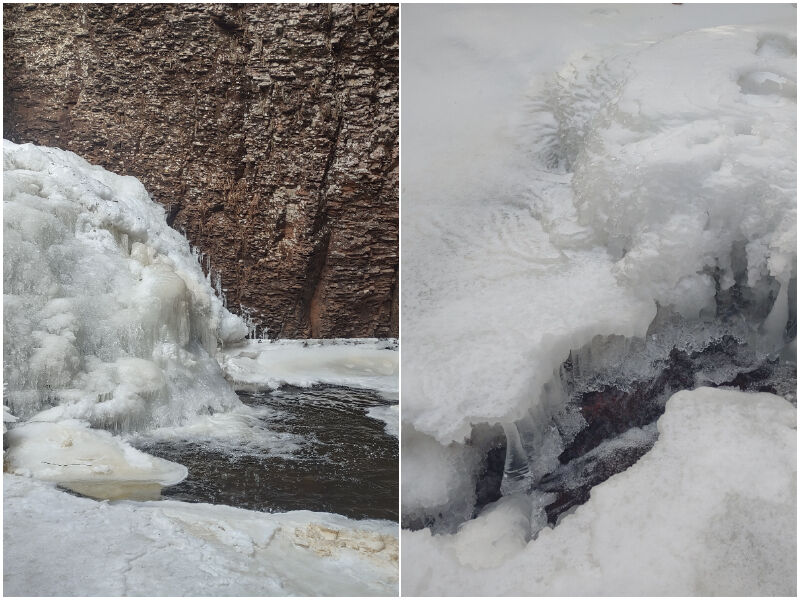The surface of the Superior Hiking Trail alternated between dry pine needles and compacted ice as we followed it into the woods. With clear blue skies the day before, temperatures had plummeted into the teens overnight, and were now rising quickly again under the discontinuous cover of wispy clouds. I can’t help but repeat the refrain…what a weird winter!
As our world changes, I’m grieving my old friends cross-country skiing (on natural snow) and the subnivean zone, while still making a point to appreciate new delights. I can’t even count how many times I’ve looked at the frozen surface of a North Shore river and wanted to walk the whimsical ice formations up through bedrock canyons. But on past visits the snow was too deep, the wind chill too brutally cold, or the skiing too good to choose that adventure.
This past weekend, conditions were finally perfect! Temperatures have been just cold enough overnight to solidify the ice over the shallow waters of the Kadunce River. The thin snow cover facilitates that by not insulating ice against the nighttime freeze. The skiing is almost nonexistent, and the sunshine pleasantly warm. So, our shoes crunched lightly on the grippy coating of snow as we stepped down the bank from the dry path onto the trail of river ice.
I was a little surprised at how solid the ice felt, even when we stepped near patches of open water. In such a small, bony, stream, there’s a good chance that we were supported by rocks as well as water. It’s different on a lake. Something I choose not to think about very much is that when you drive a truck out on the ice to go fishing, you’re actually being supported by the water. The ice sags under your weight and displaces water equal to the truck’s mass, creating buoyancy. If the ice is brittle and cracks instead of deforming, your “boat” now has a hole and sinks.
On such a small river, we weren’t worried. I was fascinated, though, by the formations visible through the small ice “windows.” The surface was rippled and mixed with snow, while the lowest ice was tickled by the chuckling stream still flowing beneath. In between was a nice layer of columns, stalactites, and clusters of little bulbules.
Especially in a warm winter like this one, ice formation is a dynamic process. In a lake, the coldest water becomes less dense and rises toward the surface, where it freezes. In a stream, turbulence mixes the water and no layer of almost-freezing water can stay at the top. Instead, tiny crystals of frazil ice form, especially in the top inch or so of moving water, and tumble around. As air temperatures drop, the water temperatures decline, too, even going just below the freezing point. Once “supercooled,” the frazil crystals are primed to freeze to each other or to other surfaces. Ice attaches to rocks, the shore, or other frazil crystals, and spreads from there.
Admiring the lumpy but elegant ice covering a head-high waterfall, I guessed that it must also form by supercooled frazil ice first sticking to rocks and then to itself. Moving water still flickered under the thin shell.
The edge of the plunge pool under the waterfall was still open, where cold had not yet overcome turbulence. I was amazed, though, that much of the surface was frozen. Petrified ice pancakes were an indication of the iterative process of ice formation in this warm winter. When the plunge pool was more open, chunks of broken ice or clumps of frazil crystals would have been caught in the eddies and spun into each other, rounding all of their corners and creating a raised rim of slush. Then, the surface froze around this pancake ice.
Around the opening to several “breathing holes” where we listened to the sweet music of running water, delicate crystals of hoar frost added even more elegance. Water vapor in the air, rising from the liquid river, crystallized directly onto the chilled surface of the ice. Like snowflakes, the crystals of hoar frost grow with exquisite precision based on the chemistry of water.
Adding to the magic of the day were the vertical canyon walls. The Kadunce River cuts through an impressive formation of flow-banded rhyolite. About a billion years ago, an immense volcano many miles inland erupted so violently that a huge mass of ash tumbled toward what is now Lake Superior. The movement of the flow caused the formation of little layers or bands, and eventually the ash solidified into rhyolite. Now the river cuts downward through the rock and exposes pale pink walls with inch-thick bands.
From ancient rocks to frozen rivers, and even weird weather within the larger context of climate change, the Earth creates beauty in its own time.
Emily’s award-winning second book, Natural Connections: Dreaming of an Elfin Skimmer, is available to purchase at www.cablemuseum.org/books and at your local independent bookstore, too.
For more than 50 years, the Cable Natural History Museum has served to connect you to the Northwoods. Our exhibit: “The Northwoods ROCKS!” is open through March 9. Our Winter/Spring Calendar of Events is ready for registration! Follow us on Facebook, Instagram, YouTube, and cablemuseum.org to see what we are up to.
Last Update: Feb 27, 2024 5:47 am CST

















